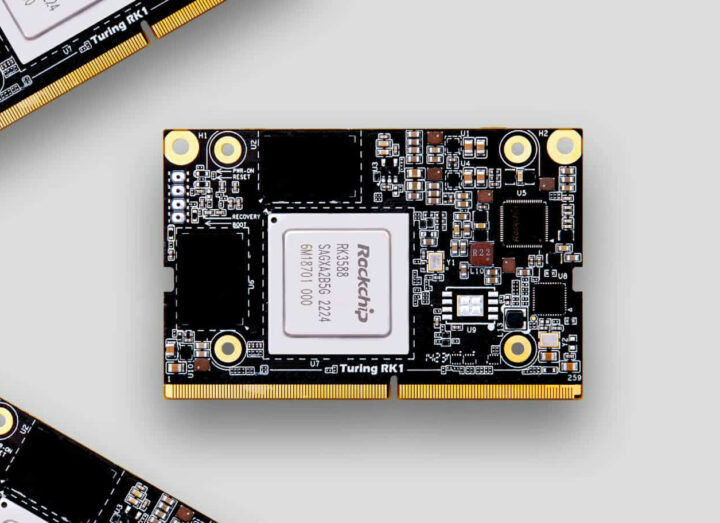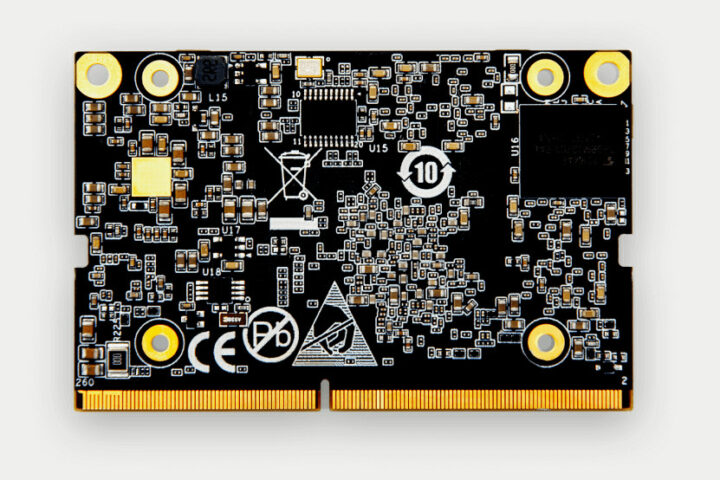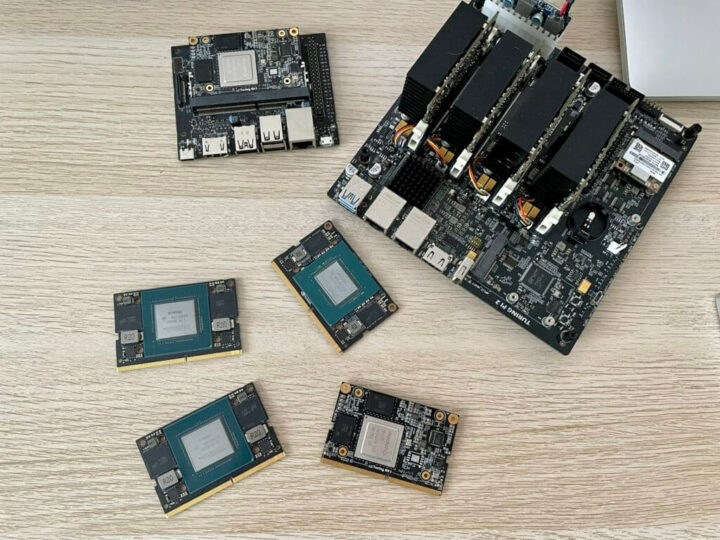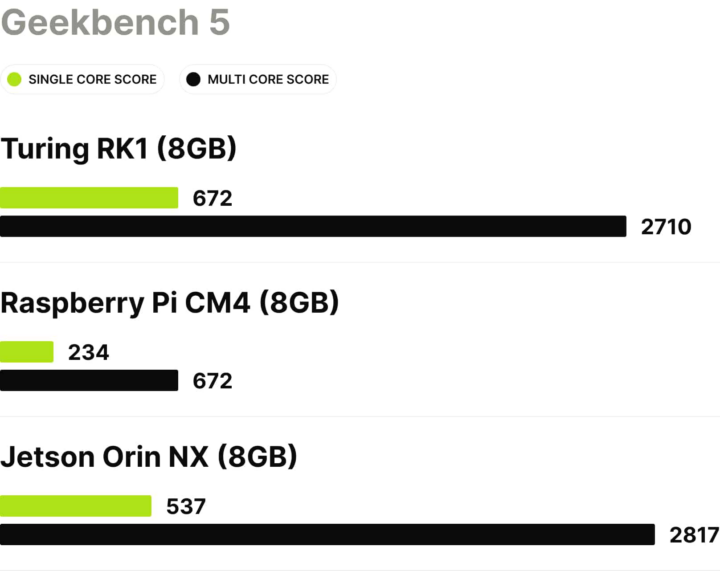Turing Pi has been making mini-ITX cluster boards for Raspberry Pi CM4 and NVIDIA Jetson modules for over four years, but last year, the company teased their own Turing RK1 system-on-module based on a powerful Rockchip RK3588 Arm processor with 6 TOPS NPU while launching the Turing Pi 2 cluster board on Kickstarter and raising over 2 million dollars in the process.
The Turing RK1 is now available for pre-order with the 8GB RAM going for $130, the 16GB model for $170, and you’d have to spend $260 if you need 32GB RAM. Most people will probably want to add $10 to purchase the RK1 heatsink with a built-in fan as well. Pre-orders are expected to start shipping on October 27.
Turing RK1 specifications:
- SoC – Rockchip RK3588
- CPU – Octa-core processor with 4x Arm Cortex-A76 @ 2.4 GHz, 4x Arm Cortex-A55 @ 1.8 GHz
- GPU – Arm Mali-G610 MP4 GPU with support for OpenGL ES 1.1, 2.0, and 3.2, OpenCL up to 2.2, and Vulkan 1.2
- VPU
- Video decoder: H265, H264, VP9, AV1/AVS2 up to 8Kp60 (10-bit)
- Video encoder: 8K H.265 and H.264 encoder, JPEG encoder
- AI accelerator – 6 TOPS NPU
- System Memory – 8GB, 16GB, or 32GB LPDDR4
- Storage – 32GB eMMC 5.1 flash
- 260-pin SO-DIMM connector that follows Jetson Nano and NX modules design
- Storage – SD 3.0 interface
- Display I/F – HDMI 2.1 up to 8Kp60, DisplayPort 1.4, 2-lane or 4-lane MIPI DSI
- Camera I/F
- 2x 4-lane MIPI CSI Rx interfaces
- 1x 4-lane MIPI CSI DPHY Rx interface
- Audio – 2x I2S
- Networking – Gigabit Ethernet
- USB – 2x USB 3.0, 2x USB 2.0
- PCIe – PCIe Gen 3.0
- Power Supply – 5V @ 3V via USB-C interface
- Dimensions – 69.6 x 45 mm
- Weight – 17 grams
- Temperature Range – Operating: -20°C to 70°C; storage: -40°C to 85°C
The module comes preloaded with Ubuntu Server 22.04 LTS with Linux 5.15 LTS kernel, and some documentation is available with the specs and instructions to use the 6 TOPS NPU with the RKNN toolkit v2. Since the Turing RK1 system-on-module is compatible with Jetson Nano and NX modules, it can not only be used with the Turing Pi 2 cluster board, but with other carrier boards made for Jetson modules with a SO-DIMM edge connector. For example, it can replace the Jetson Nano in the official developer kit as shown below.
The single-core and multi-core integer performance of the Rockchip RK3588 is much higher (about four times better) than the one of the Broadcom BCM2711 found in the Raspberry Pi CM4 module and about the same as the one of the Jetson Orin NX, at least according to Geekbench 5 [Update: Turing appears to be picked GeekBench results showing a lower score than normal for the 6-core NVIDIA Jetson Orin NX 8GB that was underclocked. See comments section]. But obviously, the Jetson Orin NX is much more powerful when it comes to AI inference with 70 to 100 TOPS, compared to the meager 6 TOPS of the RK3588 NPU. It also costs over three times as much as the RK1 module in the same RAM configuration. It all depends on what you want to achieve.
Turing says users can mix and match Compute Module 4, Jetson Nano/NX, and RK1 modules on the Turing Pi 2 mini-ITX cluster, so you have a powerful NVIDIA Jetson Orin NX 8GB for demanding AI workloads, and more affordable RK1 or CM4 modules in the other slots.

Jean-Luc started CNX Software in 2010 as a part-time endeavor, before quitting his job as a software engineering manager, and starting to write daily news, and reviews full time later in 2011.
Support CNX Software! Donate via cryptocurrencies, become a Patron on Patreon, or purchase goods on Amazon or Aliexpress. We also use affiliate links in articles to earn commissions if you make a purchase after clicking on those links.








RK3588 only support H264, H265, JPEG video encoding(base on datasheet)
You’re right. I copied this from the Turing website and missed the error. I’ve corrected it.
2GB and 4GB options plz plz
what. You will need the RAM. At least for a fittng workload for all the nice hardware in the chip I would assume so.
> The module comes preloaded with Ubuntu Server 22.04 LTS with Linux 5.15 LTS kernel
How? Rockchip’s BSP kernel is at 5.10 and for mainline you want 6.5.0-rc1 or higher.
Edit: I see, it’s copy&paste from their website as well. So they pretty much have no clue about the messy ‘Linux on ARM’ situation.
How many PCIe lanes does the edge connector support? 2x?
> The single-core and multi-core integer performance of the Rockchip RK3588 is … about the same as the one of the Jetson Orin NX
To create their graphs the marketing BS people over at Turing Pi just selected a rather lousy Orin NX score (probably using a hexa-core variant – Orin NX comes AFAIK with 6 or 8 cores). When using a properly executed benchmark comparing both CPUs with 8 cores then RK3588 loses especially multi-threaded since Orin NX is roughly twice as fast.
They used the 8GB variant with 6 cores, the 16GB variant has 8 cores. The latter is the one used in your link, but it still does not explain the 50% difference in the multi-core score.
> They used the 8GB variant with 6 cores
But why? Ah, to prevent a reasonable apples to apples comparison.
> it still does not explain the 50% difference in the multi-core score
Easy. The marketing BS people over at Turing Pi searched here https://browser.geekbench.com/search?k=v5_cpu&q=Orin+NX and then chose the 7th entry from 21st April since there the Orin cores were only clocked with 1.5 GHz instead of the usual 2 GHz.
“if you need 32GB RAM”
Me thinking ~8-16GB for current software related demand (and shared with GPU and AI hardware) for average office, media, ai training and web tasks seems a suitable recommendation (~24-32GB for development activities with versatile compiling demand).
What are mostly sold RAM configurations (soldered, variable (SO-)DIMM) for nowadays SBC (statistics?) or Your @all experiences with RAM limitations (media, gaming, native (on SBC) development)?
MPOV is 4GB (mostly independent from (LP)DDR(3)4-5(X) speeds) is (already) somewhat limited nowadays for average, common, multi-hw tasks.
(Thx)
A 90$ difference in 32GB variant if a 32GB memory chip you can get around 35$..
If you’re talking about (SO-)DIMM then the 32GB there are a combination of eight inexpensive 32Gb DRAM chips.
Here we’re talking about two expensive 128Gb chips.